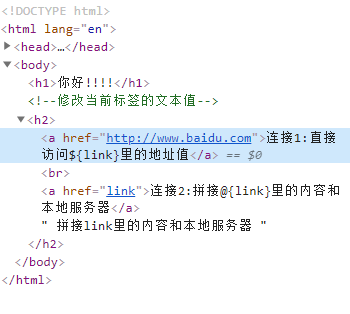Spring boot 学习(一) thymeleaf使用
<dependency> <groupId>org.springframework.boot</groupId> <artifactId>spring-boot-starter-thymeleaf</artifactId> </dependency>
引入thyme leaf starter
springboot已经自动配置好了
@Configuration(proxyBeanMethods = false) @EnableConfigurationProperties(ThymeleafProperties.class) @ConditionalOnClass({ TemplateMode.class, SpringTemplateEngine.class }) @AutoConfigureAfter({ WebMvcAutoConfiguration.class, WebFluxAutoConfiguration.class }) public class ThymeleafAutoConfiguration {}
自动配好了thymeleaf
- 所有的值都自动配在了

- 配置好了模板引擎

-
配置好了

-
接下来、只需开发页面就行
- 在thymeleaf中配置了
@ConfigurationProperties(prefix = "spring.thymeleaf") public class ThymeleafProperties { private static final Charset DEFAULT_ENCODING = StandardCharsets.UTF_8; public static final String DEFAULT_PREFIX = "classpath:/templates/"; public static final String DEFAULT_SUFFIX = ".html";
使用时,需要给html的头文件添加,就会有th的提示内容
xmlns:th="http://www.thymeleaf.org"
package com.sp.Controller; import org.springframework.stereotype.Controller; import org.springframework.ui.Model; import org.springframework.web.bind.annotation.GetMapping; @Controller public class ThymeleafController { @GetMapping("/thymeleaf") public String thymeleaf(Model model) { // model中放的数据会自动放入请求域中,类似于调用了request.setAttribute() model.addAttribute("msg","你好!!!!"); model.addAttribute("link","http://www.baidu.com"); //link,值为http://www.baidu.com
return "successful"; } } //返回到successful.html页面
关于@{link} 和${link}
<!DOCTYPE html> <html lang="en" xmlns:th="http://www.thymeleaf.org"> <head> <meta charset="UTF-8"> <title>Title</title> </head> <body> <h1 th:text="${msg}">aaaaaaaaaaaaaaaaaaaaaaaa</h1> <!--修改当前标签的文本值--> <h2> <a href="" th:href="${link}">连接1:直接访问${link}里的地址值访问连接为:www.baidu.com</a><br> <a href="" th:href="@{link}">连接2:拼接@{link}里的内容和本地服务器访问连接为:localhost:8080/world/link</a> </h2> </body> </html>
因为加了前缀,所以访问时需要加上/world 在yaml中添加了配置信息
server:
servlet:
context-path: /world
# 设置服务器访问路径



行内写法 [[${session.user.name}]]




 浙公网安备 33010602011771号
浙公网安备 33010602011771号